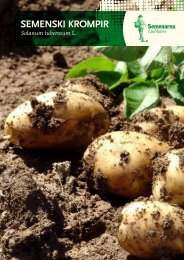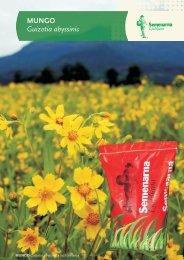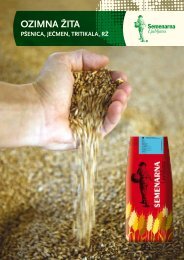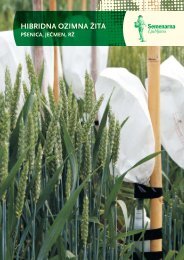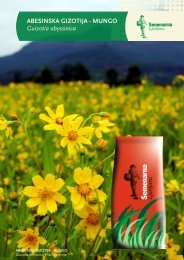katalog_ENG_20080221.indd 1 2/26/08 3:26:36 PM - Semenarna ...
katalog_ENG_20080221.indd 1 2/26/08 3:26:36 PM - Semenarna ...
katalog_ENG_20080221.indd 1 2/26/08 3:26:36 PM - Semenarna ...
You also want an ePaper? Increase the reach of your titles
YUMPU automatically turns print PDFs into web optimized ePapers that Google loves.
Valentin flowerbulbs - planted in Spring<br />
Gladiolas (Gladiolus hyb.)<br />
II-VI VII-X 100 cm<br />
Nice spikes of funnel-shaped flowers of various<br />
colours on 1 m high stems are extremely attractive<br />
and eye-catching in borders of the garden.<br />
The most delightful flower for cutting. Not over<br />
wintering.<br />
Applause<br />
Pink red<br />
Nova Lux<br />
Lemon yellow<br />
Blue Isle<br />
Dark blue<br />
47 Flowerbulbs<br />
Planting of flower bulbs<br />
Planting should be done in porous soil in an appropriate place<br />
in the garden. It is important to fertilise the soil before the<br />
planting is done with compost or thoroughly decomposed solid<br />
dung. With the exception of some of the lilies, all decorative<br />
bulbous plants tolerate limestone.<br />
They should be planted when they are in their rest period:<br />
• Summer flower bulbs (are blooming in spring) should<br />
be planted in autumn (the following rule stands: THE<br />
SOONER THE BETTER); only TULIPS should be planted end<br />
of autumn because they can contract a disease if they are<br />
planted too soon. THEY CAN BE PLANTED UNTIL THE END<br />
OF DECEMBER IF THE SOIL IS NOT FROZEN.<br />
• Summer-autumn flower bulbs (are blooming in the<br />
summer and autumn) should be planted in spring. Those<br />
that are less resistant, such as gladioli, should be planted<br />
as late as in mid spring.<br />
m<br />
Hunting Song<br />
Clear vermillion<br />
Fidelio<br />
Dark Pink<br />
How do we plant the flower bulbs<br />
• The depth is dependent on soil (in lighter soil, we plant<br />
deeper) and the size of the bulbs (the bigger the bulb, the<br />
deeper we plant it). Smaller ones are planted 5–10 cm<br />
deep, bigger ones 10–20 cm deep.<br />
• Planting should be done in groups because then their<br />
colour and shape is revealed in the BEST POSSIBLE WAY.<br />
• Do not plant too densely so that the plants will not compete<br />
for food and moisture.<br />
• Make sure you do not wound them when planting.<br />
• The planting distance is 5–7.5 cm with smaller decorative<br />
bulbous plants and 15 cm with the bigger ones. The bottom<br />
of the bulb has to be touching the soil which we loosen<br />
beforehand. There should be no air between the bottom of<br />
the pot and the bulb, because if there is some, the water is<br />
being accumulated there and the bulb can start rottening.<br />
• Tools which we are used when planting: narrow spade,<br />
punch, ordinary hand spade or HANDS, special planter.<br />
Oscar<br />
Dark red<br />
Black Jack<br />
Black red<br />
Traderhorn<br />
Red with white<br />
Wine and Roses<br />
Light pink with red<br />
Venetie<br />
Salmon<br />
Praha<br />
Azalea pink, spotted<br />
yellow<br />
Planting site of the flower bulbs<br />
• Grass, meadow, lawn: the best are on the lawn, such<br />
as daffodils, for example. Make sure that the leaves of<br />
flower bulbs die away naturally and for this reason, there<br />
should not be any mowing around them. In gentle grass,<br />
there are some other plants which do well, such as crocuses,<br />
spring star, sea bulbs, and anemones. For moist meadows,<br />
the most suitable are: Fritillaria, snowdrop.<br />
• Under the trees: especially those which are blooming<br />
before the trees are in leaves (so that they have enough<br />
light). These are, for example, anemone, spring star, sea<br />
bulbs, spring wheat.<br />
• Borders: in mixed borders where bushes and perennials<br />
are growing, there is a lot of places which are suitable for<br />
decorative bulbous plants.<br />
• For covers: especially on smaller flower beds.<br />
• Rock gardens with small bulbous plants, for example<br />
dog violet together with rhododendron (acid soil).<br />
• Decorative bowls and pots. Almost all decorative<br />
flower bulbs can be cultivated in decorative pots (flower<br />
pots and window tubs). The novelty are dahlias which are<br />
intended for planting into decorative pots. There the pots<br />
should be placed on the balconies, terraces, and also in<br />
the gardens. Flower bulbs are planted in pots together with<br />
various annual plants, perennials, or ornamental bushes.<br />
When planting into pots, the size of the pot and the place<br />
where we will put it needs to be considered (e.g., the danger<br />
of strong wind).<br />
Some interesting facts about<br />
planting<br />
Pr. Marg. Rose/Jester<br />
Red with white edge<br />
White Prosperity<br />
White<br />
When choosing the place of the planting, we need to consider<br />
the size of the plant (e.g., Fritillaria imperialis should grow behind<br />
other plants because it is big and gives off acid smell,<br />
which some plants dislike).<br />
We must consider the time when their leaves are dying off.<br />
At that time, other annual flowers or smaller bushes should<br />
cover them. If all that is considered, the garden will not look<br />
neglected.<br />
<strong>katalog</strong>_<strong>ENG</strong>_<strong>20<strong>08</strong>0221.indd</strong> 47<br />
2/<strong>26</strong>/<strong>08</strong> 3:38:59 <strong>PM</strong>










